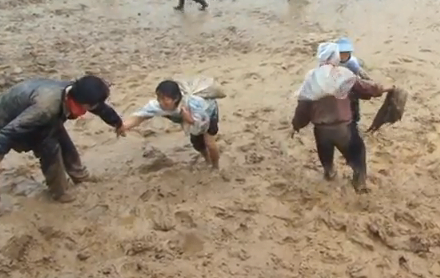There’s the North Korea that Parag Khanna visited, which sounds lovely.
Despite Typhoon Bolaven battering the country at the start of our visit, we came during a week when student groups, worker units, and families from all parts of the country flocked to Pyongyang for the Arirang mass games, which take place in the 150,000-capacity May Day stadium and feature up to 100,000 performers in the most spectacularly choreographed precision movements ever staged — almost every single night…
North Korea does indeed have plenty to offer. Its largely mountainous territory is rich in gold and magnesium. Mining operations are picking up, with serious interest from Australia and other extractive giants. Its mighty rivers could be key hydropower resource both to electrify the country and sell power to the South. It also produces agricultural staples like rice, corn, soybeans and potatoes. And of course there could be much more tourism, including to scenic Mt. Paekdu and to witness the centuries of well-preserved Korean traditions in Pyongyang. For example, Beijing-based Koryo Tours has increased its tourist volume from 200 to 2,000 over the past decade, almost half of which are American.
The nation’s capital, the largest of its half-dozen large cities, feels like an Asian Kiev. Like Ukraine’s capital, it has broad avenues with revolutionary monuments and fountains, but also a laid-back, leafy feel. Czech made trams still roll through the city ferrying workers and students between homes, offices, and schools.
North Koreans are not automatons but citizens, loyal but misinformed, curious and educated. Whether in schools, billiard halls, or karaoke bars (Some Pyongyang girls have perfected Celine Dion’s “Titanic” theme song), the people can be quite open about their concerns. Some mothers would rather their kids practice the piano than spend hours training for the mass games; some teachers want their kids to focus more on math.
And then there’s the North Korea in which about one out of 5 kids under two-years-old are malnourished; 13 years-old stunted from hunger look like they are 8 years old; and nearly 40% of the spring harvest was lost to drought while Typhoon Bolavan threatens the autumn harvest. From the World Food Program:
It is easier for humanitarians than journalists to access parts of North Korea that the authorities would probably not want visiting. This is why the media platforms from groups like Unicef and WFP –which have operations in every global humanitarian crisis– are so important. To be sure, the information is filtered to serve a purpose (in this case, to educate the general public about malnutrition in North Korea and the good work of the WFP). But the stories they tell are nonetheless important and outside the realm of what a traditional journalist can accomplish in such a closed society.
I would imagine that Parag Khanna’s article would have been much different should he have been able to visit places outside the capital.
